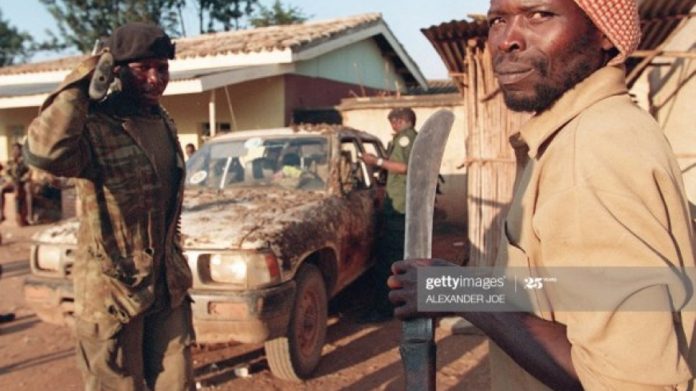By Marc Matabaro
On May 21, 2020, the Rwandan pro-government newspaper, The New Times, headlined: “New photo of Genocide fugitive Ramadhan Muhire surfaces”, According to the article ” A new photo has emerged of Ramadhan Muhire, a genocide fugitive whose identity was recently unmasked, 26 years after the 1994 Genocide against the Tutsi. An IT service management company that offers different solutions, AWS Amazon, identified the photo with 72.1% match with a previous photo of him holding a machete during the Genocide against Tutsi”.
The Rwandan in its investigation found that this article from The New Times, is a story made up from scratch and which shows wickedness beyond belief!
It is indeed an injustice which started in 1994 and whose first victim is Appolinaire who lives in Muhanga and it is now the turn of Muhire Ramadhan who lives in Zimbabwe.
The reality is that the old man with the machete is Appolinaire nicknamed Kaguru (the leg) because he is lame. He lives in Ruli in the city of Muhanga (former prefecture of Gitarama). He is a poor citizen, living of agriculture and repairing damaged utensils.
Poverty does not prevent him from being exemplary, innocent and Christian. In the Catholic Church of Ruhina (Saint Andrew’s Church), he is responsible for security, and directs Christians by showing them their seats in the church on Sundays and public holidays. It is a responsibility entrusted to a good volunteer Christian.
In 1994, he left his house to go to work in his field with a machete. As we can see on the picture, he was just on his way on a paved road, arriving in front of a commercial house which housed a shop and a pharmacy opposite the Zenith Bar belonging to Muganza. The house in the picture belongs to Twagirumukiza Vianney, son of Gahirima.
Arrived at that place, Appolinaire found soldiers together with white people. They stopped him, talked to him. He told them he was going to the field. They photographed him, as he could do nothing to oppose this, he accepted and then they let him go.
A few days later, he was surprised to learn that people had seen a picture of him on television and in genocide memorial sites he was said to be an Interahamwe who had participated in the genocide. He appealed in vain to various authorities to ensure that his photo did not continue to be used in that way. Instead he was summoned by the Gacaca court at the office of the Shyogwe sector.
He defended himself in court, several people who had seen him being photographed testified and he was cleared and returned home hopping that he will be reinstated into his rights. So far, this has not been possible because his picture continues to circulate, with assumptions that he is an Interahamwe who participated in the massacres.
Some Members of the bench of the Gacaca court which summoned Appolinaire to examine the case of the photo are:
1. Mukayisenga Aurélie, retired teacher,
2. Murererehe Mediatrice, nicknamed Mama Aimée, she was court secretary,
3. Fideli, a former police officer known as Papa Nyampinga,
4. Espérance, wife of an RDF (current Rwanda Defense Force) soldier with the first name of Gaston and other people whom our informants do not remember.
We do not know how this picture of an Apollinaire living in Muhanga can become that of Muhire Ramadhan who lives in Zimbabwe and who was born in Kibungo. Unless they find another evidence, the photo cannot be used against him, the photographed person is there and does not deny that it is his photo and has the sufficient evidence of how he was photographed.
It should be noted that on the original photo, one can read: “picture dated 12 June 1994 showing an Interahamwe Hutu militiaman holding a machete in Gitarama, center Rwanda. (Photo credit should read ALEXANDER JOE / AFP / Getty Images)”. This mention sticks with the version of Apollinaire living in Muhanga much more than the version of The New Times which talks about Muhire Ramadhan who lives in Zimbabwe and was born in Kibungo.





























































